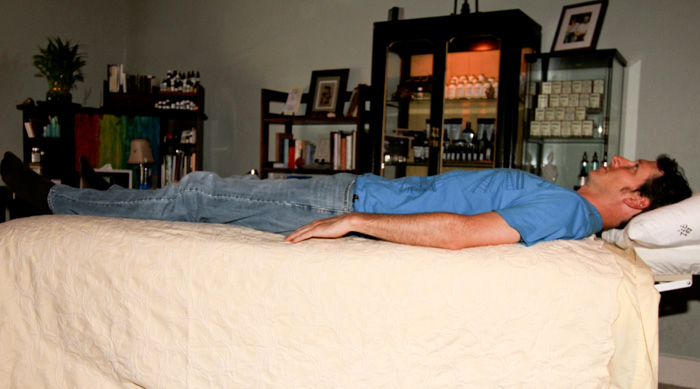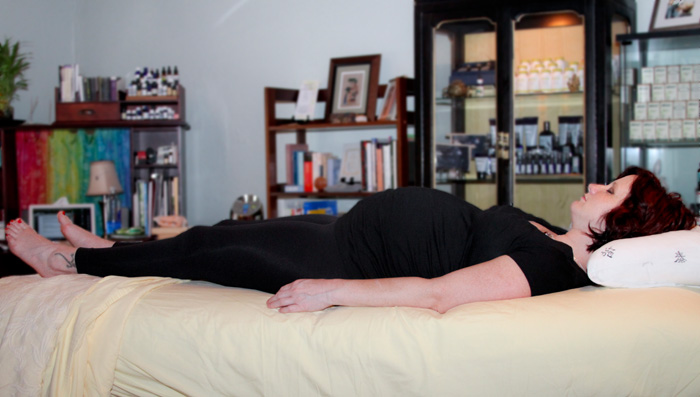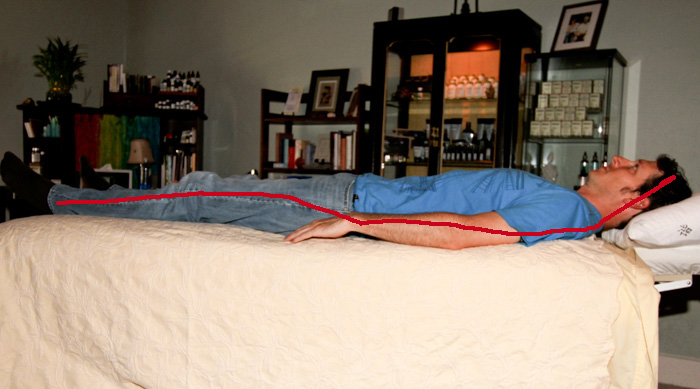SLEEP HYGIENE
"I'm not sleeping well" is a common complaint. Weather, current events, time changes, and internal body changes can contribute to interrupted sleep. Some people even think sleeping 8 hours is a waste of time!


Most people sleep in one of these positions, yet report that they are not refreshed, or experience aches when arising.
Research shows that in many illnesses a change of diet and regular sleep habits create the ability to heal. The eight hours of sleep are not being wasted; rather, because of those eight hours, you are able to stay awake for sixteen hours. Otherwise you would not be able to stay awake all that time. Also, the position in which you sleep contributes to the restfulness and re-harmonizing of the body. The photos above are typical of how many people sleep, but their bodies are not being supported for restorative energy.
During those eight hours of sleep, life-energy is accumulated: your life gets revitalized, the centers of your brain and heart calm down, and your life functions from your navel center. For those eight hours of sleep you have again become one with nature and with existence. That is why you become revitalized. It is very important for a meditator to see to it that he sleeps properly and enough,, otherwise meditation becomes a nap. Understand— right sleep will be different for everybody, according to age and to many other elements.
Research also says that there cannot be one fixed time for everyone to wake up. It was always said that to wake up at five o’clock in the morning is good for everyone. It may be good for some people but it may be harmful for other people. During each twenty-four hours, for about three hours, the body temperature of each person goes down. Those three hours are the hours of deepest sleep. If the person is woken up during those three hours, his whole day will be spoiled and his whole energy will be disturbed.
For most people these three hours are between two to five in the morning, but it is not the case with everyone, especially those who go to sleep after midnight. For some people their body temperature is low until six o’clock, for some it is low until seven. For some their temperature starts becoming normal at four in the morning. If someone wakes up within these hours of low temperature, all twenty-four hours of his day can be spoiled. There will be harmful effects, such as losing focus or mental acuity, carrying greater amounts of stress and being unable to digest food well or breathe properly. Only when a person’s temperature starts rising to a normal level is it time for him to wake up.
Some wake up with the rising sun, because as the sun rises everyone’s temperature starts rising. For some, it may be necessary to sleep a little later than sunrise, because each individual’s body temperature rises at a different time, at a different pace. Each person should find out how many hours of sleep he needs and what is a healthy time for him to get up. For the right sleep, the deeper and the longer you are able to sleep, the better.
Sleep is also enhanced by the following:
1. A dark room. Even the glow of the alarm clock can affect the pineal gland, the Master Gland, that signals appropriate hormone functions for the day. The pineal gland is affected by light, so add in a computer power light blinking, the red button from the TV power signal, night lighting from outside coming in through the window and pretty soon the pineal is thrown off. Turn appliances away from your bed, but a cloth or post-it over the red dot, place the computer in another room, place your phone in a drawer, use room darkening curtains or shades. If it is still light enough to see you way around the room, get a sleep mask.
2. Have a nighttime routine. Most of us as children had a routine that occurred at the same time in the same way. Dinner, play, bath, book and snuggle, lights out. As a grownup, create your own routine in the evenings, allowing an hour for the brain to unwind from LED stimulation by turning off the TV and computer and taking a 20 minute warm (not hot) bath or shower, followed by a foot massage or scalp massage. The massage will direct the nervous system that it is time to relax, and let your body know you are caring for its well-being.
3. Place your pillows in a supportive position, close your eyes and deep breathe, releasing the tension from every part of your body. The following instructions show you how to place your pillows for restful sleep positioning. With proper support, you body stays in one place and restores rather than is restless, tossing and turning.
Below are the 3 common sleep positions for a non-pregnant person, with adaptations for a more restful sleep, followed by pregnancy positioning for better health for mom and baby.

Normal: Most common positioning to fall asleep is on your back. Usually used for better breathing, less wrinkling of face and chest; however, partners complain of snoring, and sleeper reports neck pain upon arising, and body wakes in different position without proper support. Note how the red lines are angled: head and neck at 60 degrees (neck pain, compression on esophagus for acid reflux, and palate affected so that snoring occurs while breathing through open mouth); chest slumped into mattress (poor exchange of breath due to diaphragm compression); hips at 30 degrees (stagnancy of venous and lymphatic circulation, can lead to sciatica, constipation).